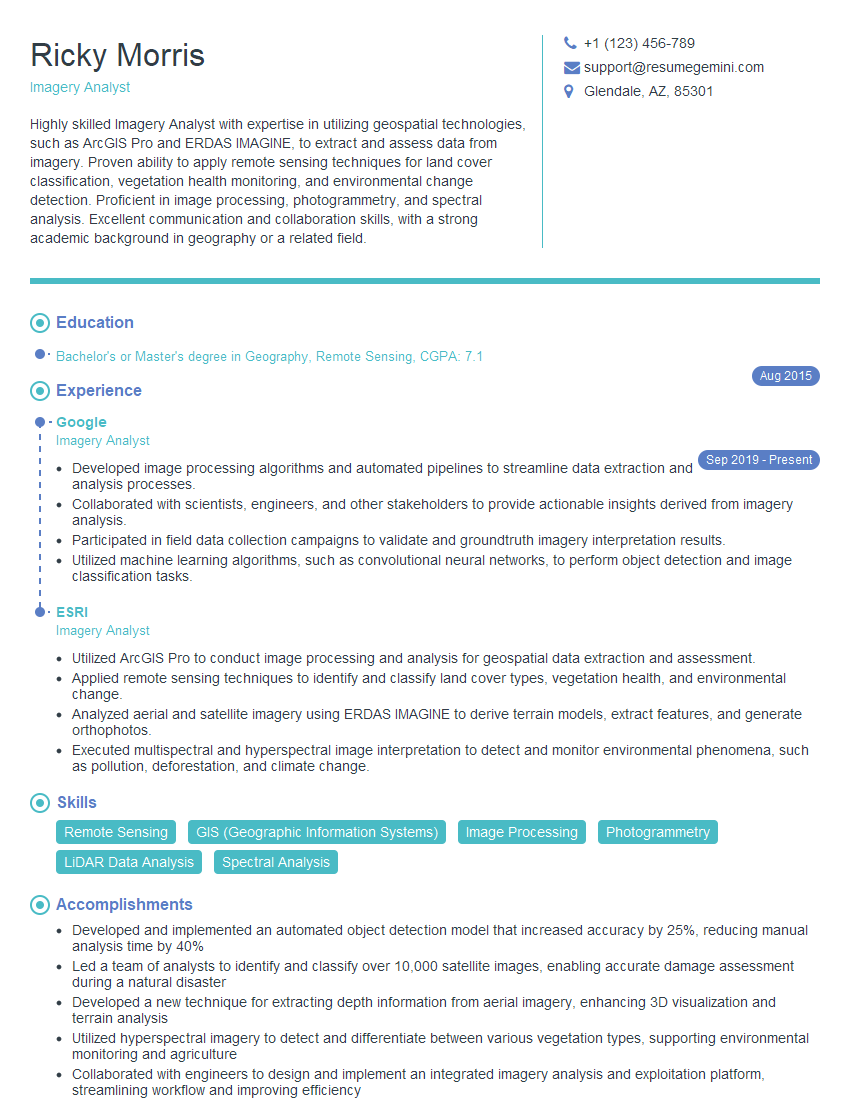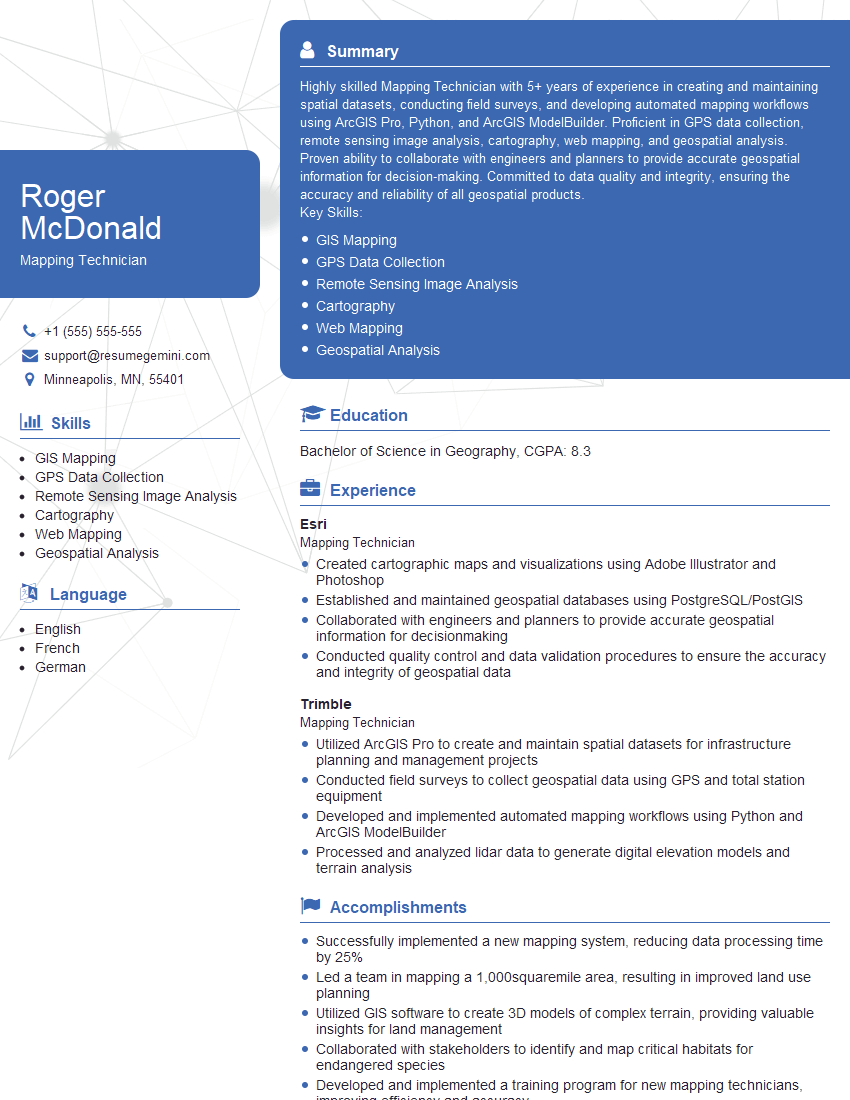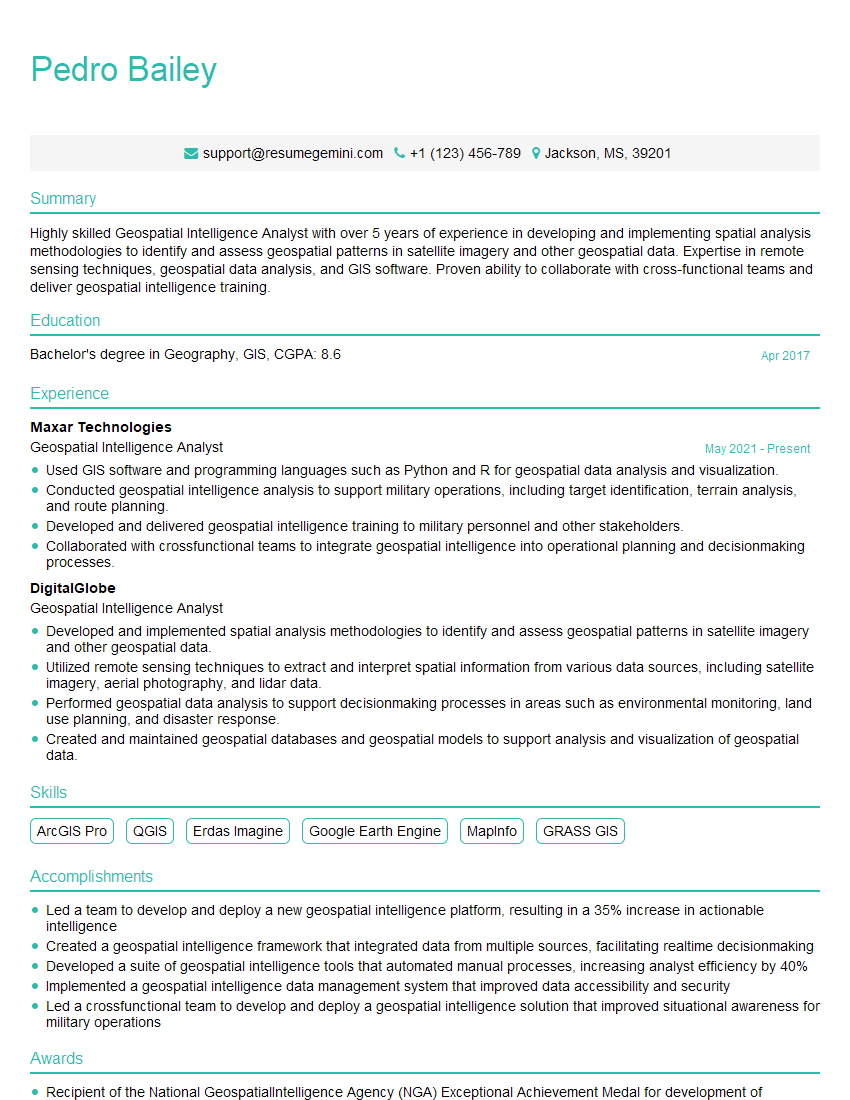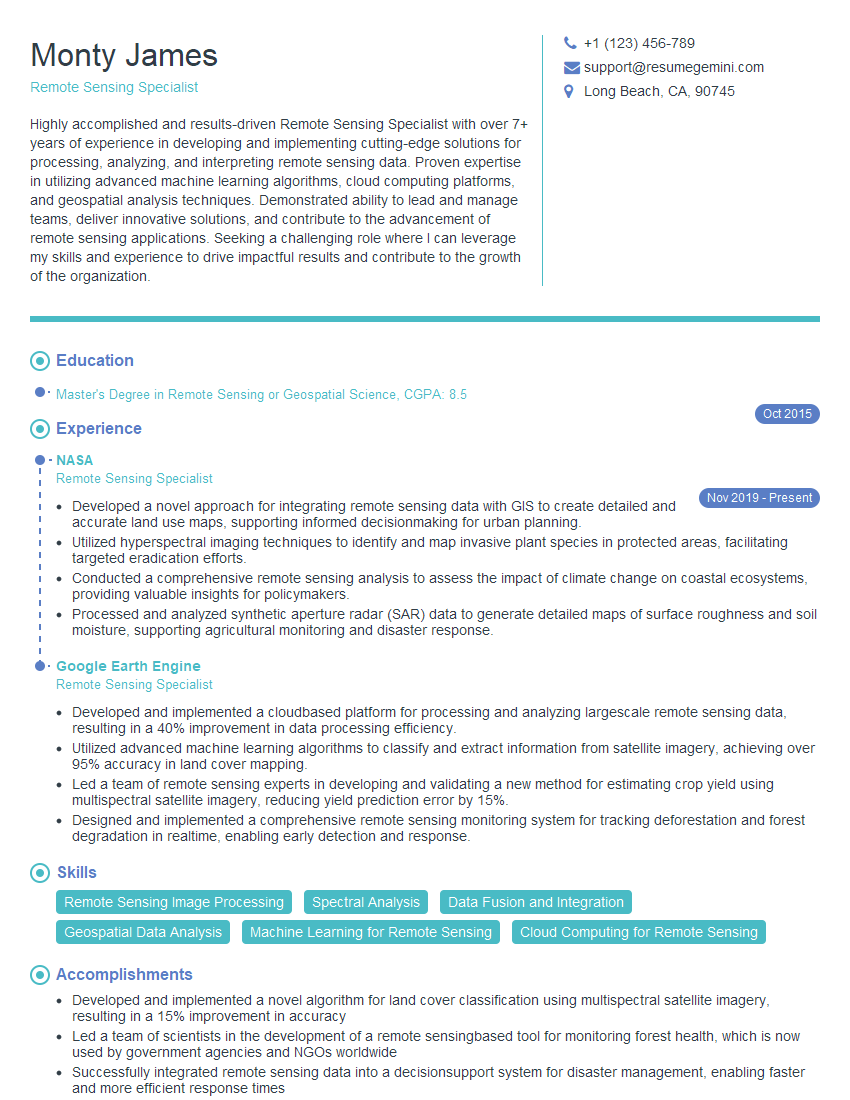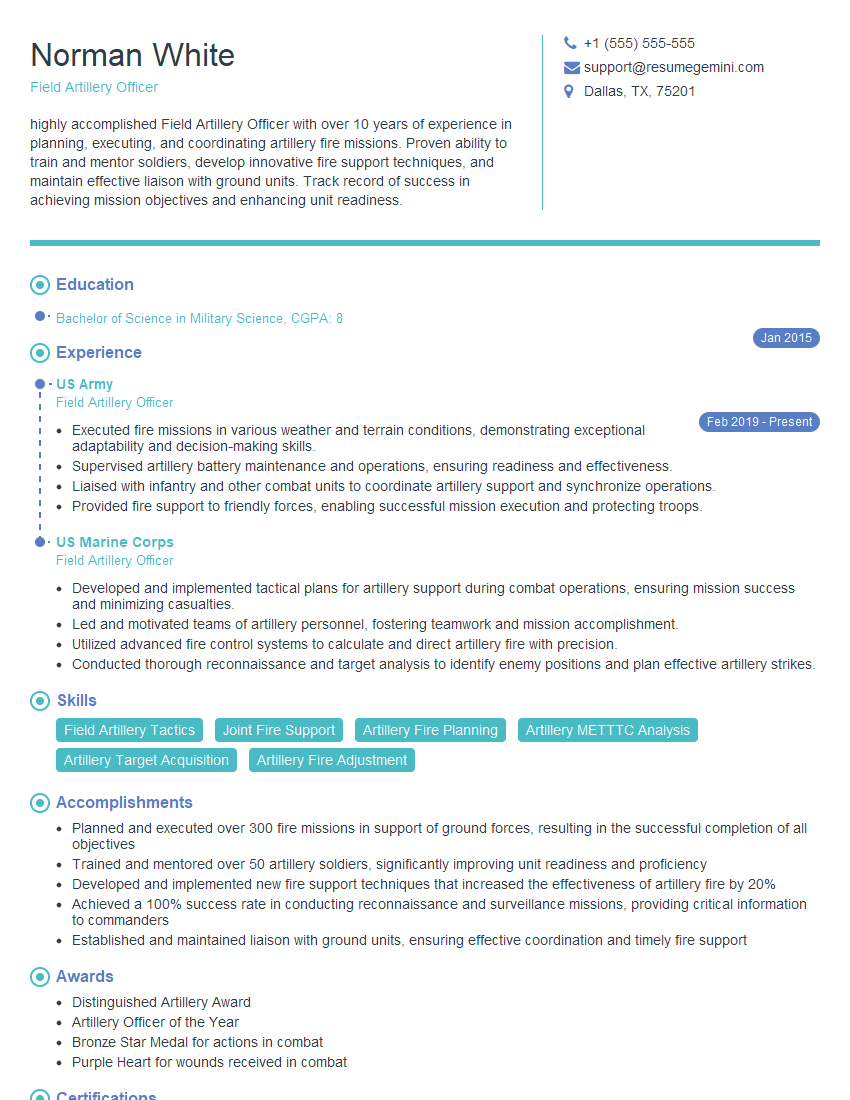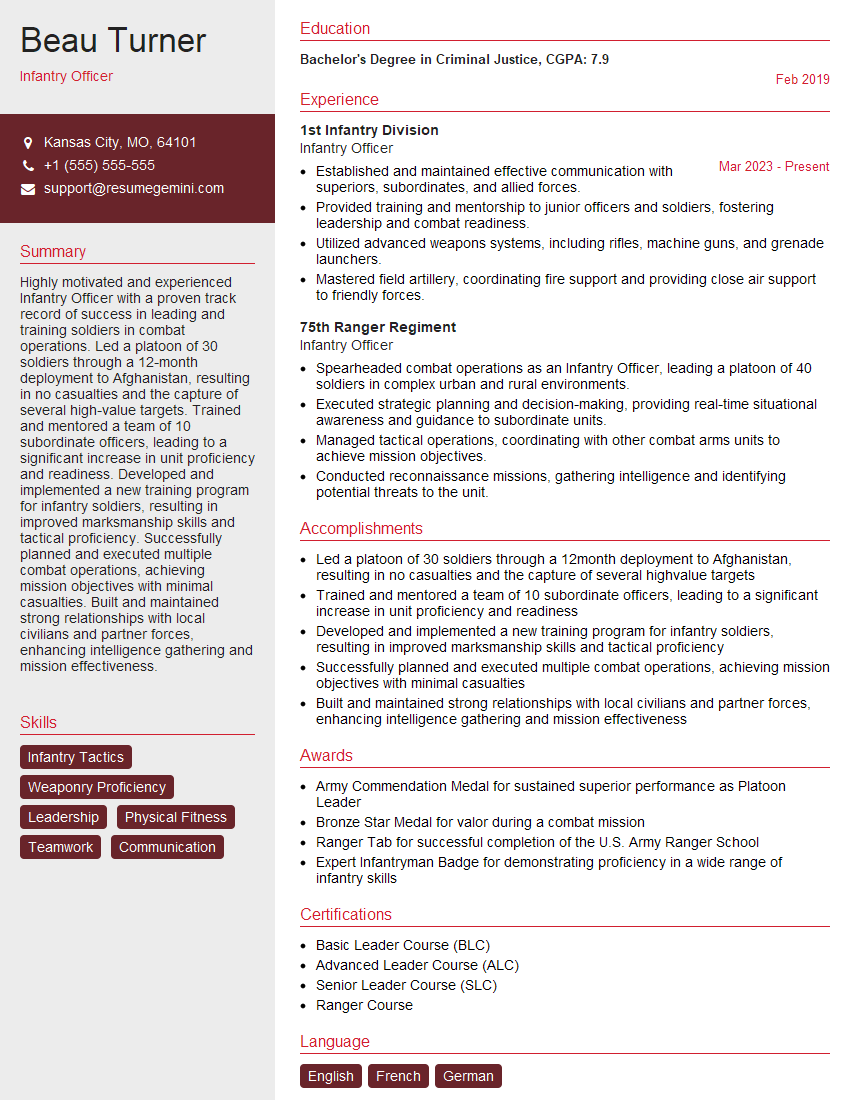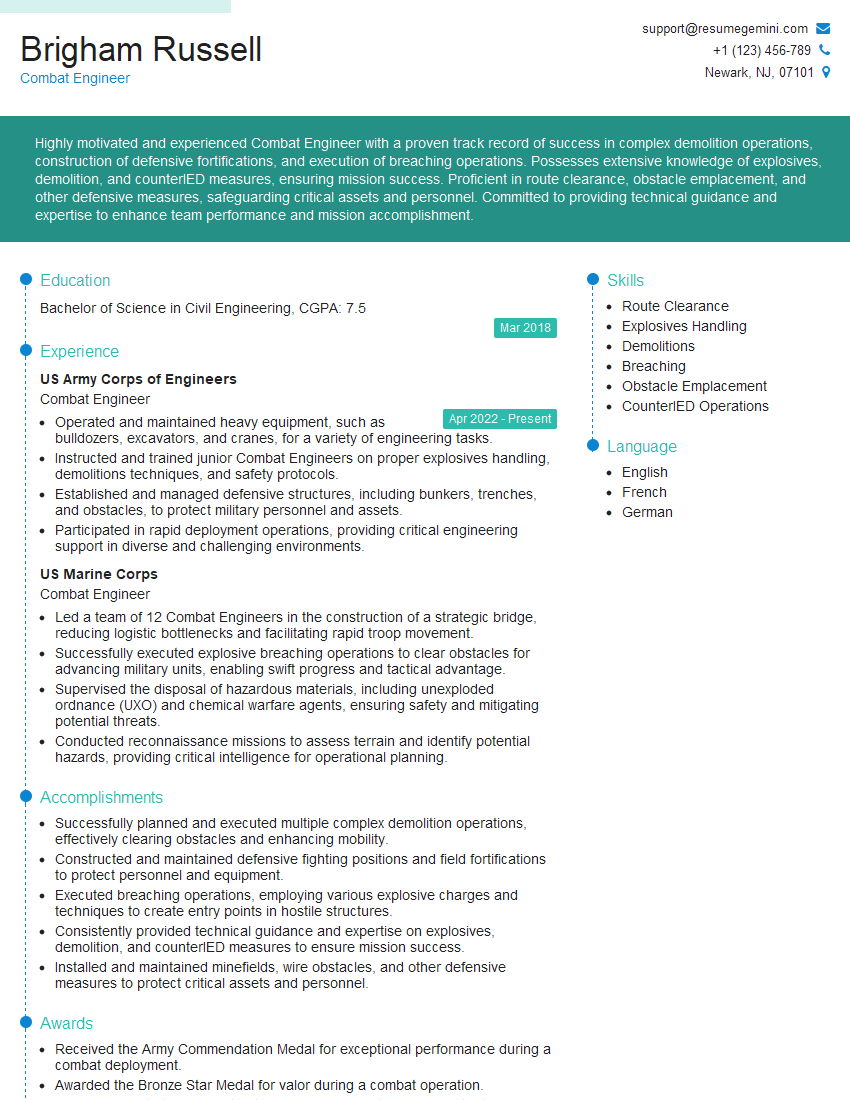Every successful interview starts with knowing what to expect. In this blog, we’ll take you through the top Reading Military Maps interview questions, breaking them down with expert tips to help you deliver impactful answers. Step into your next interview fully prepared and ready to succeed.
Questions Asked in Reading Military Maps Interview
Q 1. Explain the different types of military map symbols and their significance.
Military maps utilize a standardized system of symbols to convey a vast amount of information concisely. These symbols represent everything from terrain features and man-made structures to troop units and planned operations. Understanding these symbols is crucial for effective military planning and execution.
- Point Symbols: These represent features occupying a single point, such as a building (square), a well (circle with cross), or a command post (a star inside a square). The size and color often indicate additional details – for instance, a larger building might represent a significant structure.
- Line Symbols: These denote linear features, like roads (various thicknesses and colors for paved vs. unpaved), railroads (double lines with small dots), or rivers (blue wavy lines). Line symbols can also represent boundaries or lines of communication.
- Area Symbols: These symbols cover an area on the map, such as forests (green shading), orchards (small tree symbols within an area), or swamps (blue irregular shading). Their pattern and color provide crucial context.
- Unit Symbols: These represent military units and their composition, indicating type (infantry, armor, artillery) and size. They use standardized shapes and markings to quickly convey force strength and disposition. For example, a triangle might represent an infantry unit, while a diamond might denote an armored unit. The number inside the symbol might represent unit size.
Imagine you’re planning an assault. Recognizing the symbol for a heavily fortified building (a large, shaded square) versus a lightly defended one (a small square) is critical for planning the attack’s timing and intensity. Understanding unit symbols helps you anticipate enemy movements and plan accordingly. The ability to rapidly interpret these symbols translates directly into battlefield advantage.
Q 2. Describe the process of determining grid coordinates on a military map.
Determining grid coordinates is fundamental to precise location identification on a military map. Military maps use a grid system, usually a Universal Transverse Mercator (UTM) grid, overlaid on the map. This system uses coordinates to pinpoint any location precisely.
The process involves identifying the easting and northing coordinates. Easting refers to the horizontal grid line and northing to the vertical grid line. The intersection of these lines determines the location.
- Locate the Point: First, locate the point on the map you need to find coordinates for.
- Find the Nearest Grid Lines: Identify the two nearest grid lines running vertically (northing) and horizontally (easting) to the point.
- Read the Northing: The northing value is read from the vertical grid line to the south of the point.
- Read the Easting: The easting value is read from the horizontal grid line to the west of the point.
- Record Coordinates: Report the coordinates as Easting, Northing (e.g., 456700, 342100). Note that grid squares have subdivisions; you’ll need to estimate the point’s position within the square by interpolating.
For example, if the northing value is 3421 and the easting is 4567, the coordinates would be recorded as 456700, 342100. The addition of zeroes ensures 6-figure accuracy which is the standard for many military applications. This level of precision is critical when coordinating artillery strikes or directing air support. A slight error in grid coordinates can have serious consequences.
Q 3. How do you convert magnetic north to grid north on a map?
Magnetic north and grid north are not always aligned; the difference is called magnetic declination. This variation is due to the Earth’s magnetic field not being perfectly aligned with the geographic poles used for grid systems. Converting between the two is essential for accurate navigation.
Military maps usually provide the magnetic declination for the map’s area, often shown as an angle in the map’s legend or margin. To convert:
- Identify Declination: Find the magnetic declination value on the map. It’ll usually specify whether it’s east or west declination. East declination means magnetic north is east of grid north, and vice-versa.
- Apply the Correction: To convert a magnetic azimuth (bearing measured from magnetic north) to a grid azimuth (bearing measured from grid north), you either add or subtract the declination angle. If the declination is east, you subtract it from the magnetic azimuth. If it’s west, you add it.
Example: Let’s say the magnetic declination is 10° East. If you measure a magnetic azimuth of 40°, your grid azimuth would be 40° – 10° = 30°.
Accurate conversion is vital because using magnetic north directly could lead to significant navigation errors, especially over longer distances. This error could lead to a military unit being mispositioned, causing potential issues with resupply, coordination with other units, or the successful completion of operations.
Q 4. What are the common methods for determining distance on a military map?
Determining distances on a military map involves using the map’s scale and various measuring tools.
- Using the Map Scale: The map scale (e.g., 1:50,000) indicates the relationship between the map distance and the actual ground distance. You can measure the distance on the map using a ruler and then apply the scale to calculate the real-world distance. This is a straightforward method but can be less accurate for longer distances.
- Using the Map’s Bar Scale: Many military maps include a bar scale, a graphical representation of distance. You simply match the measured distance on the map against the bar scale to find the actual distance. This method is less prone to errors related to improper ruler usage.
- Using a Map Measurer: A map measurer or a pair of dividers helps measure distances more precisely, particularly along curved lines or across varied terrain. These tools offer greater accuracy than a simple ruler.
Imagine planning a patrol route. Accurately determining the distance to the objective is crucial for estimating travel time, fuel consumption, and resupply needs. Misjudging the distance could leave your unit vulnerable or compromise the mission’s success.
Q 5. Explain the concept of contour lines and their use in terrain analysis.
Contour lines are perhaps the most important features for understanding terrain on a military map. They connect points of equal elevation, providing a visual representation of the land’s three-dimensional form.
Contour lines reveal:
- Elevation: The closer the contour lines, the steeper the slope. Widely spaced lines indicate a gentle slope.
- Slope Direction: The direction contour lines curve indicates the direction of the slope.
- Terrain Features: The pattern of contour lines helps identify hills, valleys, ridges, and saddles. Concentric circles indicate a hilltop, while V-shaped lines pointing uphill show a valley.
Imagine planning a movement through rugged terrain. Understanding the spacing of contour lines helps you anticipate challenging slopes and plan routes that minimize exposure and maximize tactical advantage. Contour lines allow you to ‘visualize’ the 3D landscape and make informed decisions about movement and positioning.
Q 6. How do you identify and interpret elevation on a military map?
Elevation is represented on military maps primarily through contour lines, but also through spot heights and bench marks.
- Contour Lines: As mentioned, contour lines connect points of equal elevation. The numerical value of the elevation is usually indicated on the lines at intervals.
- Spot Heights: These are points marked with their exact elevation, often written as a number with a small circle around it. They give precise elevation data for specific locations.
- Benchmarks: These are permanently marked points of known elevation established by surveying, providing reliable elevation references.
Knowing the elevation is essential for various military tasks. For example, when planning artillery fire, the elevation difference between the artillery position and the target heavily influences the trajectory calculations. Furthermore, understanding elevation changes helps to determine areas suitable for defensive positions, observation posts, and movement routes. A clear understanding of elevation ensures the safety and efficiency of military operations.
Q 7. Describe the different types of terrain features depicted on military maps.
Military maps depict a variety of terrain features using a combination of symbols, shading, and contour lines. Understanding these features is critical for tactical planning and operational success.
- Relief Features: These are natural landforms, including hills, mountains, valleys, ridges, saddles (low points between hills), and depressions. Contour lines are essential for interpreting these features.
- Water Features: Rivers, lakes, streams, canals, and swamps are typically depicted using blue lines or shading. Their representation is crucial for planning routes, identifying water sources, and assessing potential obstacles.
- Vegetation: Forests, orchards, and cultivated land are represented through different symbols and shading. Understanding vegetation can help assess cover and concealment for troops or equipment.
- Man-Made Features: Roads, buildings, railroads, bridges, and other human-made elements are represented using specific symbols. These are essential for route planning and understanding infrastructure.
- Cultural Features: This encompasses features such as towns, villages, and other populated areas. Their representation helps understand the human landscape and plan logistical needs.
Imagine you’re planning a night operation. Understanding the terrain features, like the presence of dense forest (shown through green shading) or a significant river (a blue line), will heavily influence your route planning and the choices you make for concealment and cover. The detailed depiction of terrain features allows for thorough mission planning and reduces the risk of unexpected obstacles or surprises.
Q 8. How do you use a military map and compass to navigate?
Navigating with a military map and compass is a fundamental skill for any soldier or field operative. It combines the map’s representation of the terrain with the compass’s ability to show direction. The process relies on understanding grid coordinates, bearings, and terrain features.
The process involves:
- Orientation: First, orient your map – aligning its north with the magnetic north indicated by your compass. This ensures the map accurately reflects your current location and surroundings.
- Location: Determine your precise location on the map using at least two identifiable features (e.g., intersections of roads, prominent buildings, or distinct geographical features). This is called resection.
- Selecting a Target: Identify your destination on the map and determine its grid coordinates.
- Taking a Bearing: Using the compass, find the magnetic bearing (the direction) to your destination. This is done by aligning the compass bezel with the line you draw on the map connecting your location to your target.
- Following the Bearing: Walk in the direction indicated by the compass, consistently checking your progress against the map. Regularly resect to ensure you haven’t drifted off course.
- Terrain Association: Constantly relate the features on your map to what you see in reality. This allows you to correct minor deviations early on.
Example: Imagine you’re at a crossroads (identifiable on the map) and need to reach a radio tower shown 3km north-east. You’d take a bearing to the tower with your compass, and walk in that direction, regularly checking your map and compass to stay on track.
Q 9. Explain the process of planning a route using a military map.
Planning a route on a military map is a crucial step for mission success, ensuring efficient movement and avoiding potential threats. It’s a systematic process considering terrain, enemy positions, and logistical factors.
The process typically includes:
- Define Objectives and Constraints: Clearly state the mission’s objective (destination, tasks) and any constraints (time limits, avoidance zones).
- Analyze Terrain: Study the map meticulously, identifying terrain features (rivers, hills, forests, roads) and assessing their impact on movement. Consider elevation, vegetation density, and potential cover and concealment.
- Identify Route Options: Explore multiple potential routes, evaluating each based on terrain, distance, and potential hazards.
- Evaluate Risks: Assess potential risks along each route, such as enemy ambushes, obstacles, or weather conditions.
- Select Optimal Route: Choose the route that best balances speed, safety, and mission requirements. Document your chosen route on the map, marking key points and checkpoints.
- Contingency Planning: Plan alternative routes in case of unforeseen obstacles or enemy actions. Include escape routes or fallback positions.
Example: If planning a patrol, you’d avoid open areas vulnerable to sniper fire, choosing routes that offer cover and concealment, perhaps utilizing tree lines or valleys. You’d also note possible crossing points for rivers and plan for delays if encountering difficult terrain.
Q 10. How do you estimate the time required to traverse a given distance on a military map?
Estimating travel time is vital for mission timing and logistical planning. Several factors influence travel speed, and these should be accounted for when estimating.
Factors to Consider:
- Terrain: Flat terrain allows for faster movement than hilly or mountainous areas. Dense forests or swamps will slow progress significantly.
- Mode of Travel: Walking speed is slower than moving by vehicle or helicopter.
- Load: Carrying heavy equipment reduces speed and increases fatigue.
- Weather: Adverse weather conditions (rain, snow, fog) can dramatically reduce speed and increase risk.
- Enemy Presence: The need for caution and security measures in enemy-controlled areas will extend the travel time.
Estimating Time: Military personnel often use pre-determined speeds for different terrains and modes of transport. For instance, a soldier might estimate a walking speed of 4 km/hour on flat terrain, but only 2 km/hour in dense jungle. This speed is then multiplied by the distance (measured on the map using the map’s scale) to estimate travel time.
Example: If a route is 10km long on flat terrain, and the walking speed is estimated at 4 km/hour, the estimated travel time would be 2.5 hours. However, this time needs to be adjusted upwards if there are any challenging terrain sections involved.
Q 11. Explain the importance of map scale in military operations.
Map scale is fundamental to military operations as it determines the relationship between distances on the map and the actual distances on the ground. Accurate distance measurement is crucial for planning, navigation, and coordination.
Importance in Military Operations:
- Accurate Distance Measurement: Determining the range of weapons systems, planning movements, estimating travel times, and coordinating troop deployments all depend on an accurate understanding of map scale.
- Target Acquisition and Engagement: Pinpointing enemy positions and calculating the required range for artillery or air support demands precise distance measurements from the map.
- Resource Allocation: Effective supply chain management necessitates knowing accurate distances between supply depots and deployed units.
- Terrain Analysis: Understanding the scale helps determine the true size and scope of terrain features like hills, rivers, and obstacles, crucial for planning maneuvers.
- Map Interpretation: The scale directly impacts the level of detail shown on the map. Larger scale maps show more details, while smaller scale maps provide a broader overview.
Example: A 1:50,000 scale map indicates that 1 cm on the map represents 50,000 cm (500 meters) on the ground. A 1:25,000 scale map, on the other hand, shows the same 1 cm representing 250 meters on the ground, offering far greater detail.
Q 12. Describe how to identify potential obstacles or hazards on a military map.
Identifying obstacles and hazards on a military map is crucial for safe and effective operations. This involves a systematic analysis of various map features and symbols.
Identifying Potential Obstacles/Hazards:
- Terrain Features: Mountains, hills, rivers, swamps, forests, and cliffs are significant obstacles that impact movement speed and can limit routes. Their elevations, slopes, and density are all considered.
- Man-made Obstacles: Roads, bridges, buildings, fences, and minefields are man-made obstacles, some of which might be actively defended.
- Weather Conditions: Rain, snow, fog, or extreme temperatures are weather-related hazards affecting visibility, mobility, and soldier welfare. These might be indicated indirectly via symbols for soil type or vegetation.
- Natural Hazards: Floods, landslides, and avalanches are natural hazards that pose significant risks.
- Enemy Positions: Enemy troop locations, fortifications, or weapon emplacements, when indicated by intelligence, represent substantial hazards requiring careful route planning.
Example: A steep mountain slope might be identified as a hazard that could slow down movement and increase the risk of accidents. A river without a marked crossing point would require additional planning to ensure safe passage. The presence of enemy tank positions would require careful route selection to avoid engagement.
Q 13. How do you utilize a military map in conjunction with other intelligence sources?
Military maps form the foundation for situation awareness, but they are most effective when integrated with other intelligence sources. This integration provides a more complete and accurate picture of the operational environment.
Utilizing Maps with Other Sources:
- Aerial Imagery/Satellite Photos: These verify map features, revealing changes not reflected on older maps (new buildings, destroyed infrastructure).
- Sensor Data: Radar, thermal, or acoustic sensors provide real-time information on enemy movements or weather conditions not shown on a static map.
- Human Intelligence (HUMINT): Reports from local population or prisoners of war might reveal enemy positions, activity, or hidden obstacles not depicted on the map.
- Signals Intelligence (SIGINT): Intercepted communications might pinpoint enemy positions or their plans, further informing route selection and tactical decisions.
- Weather Forecasts: These integrate with terrain analysis to assess risks from flooding, reduced visibility (fog), or extreme temperatures.
Example: A map might show a seemingly passable road. However, satellite imagery might reveal that the road is damaged or blocked, while HUMINT might indicate enemy presence in the area. This combined intelligence allows for a more accurate assessment and informed decision-making.
Q 14. What are the limitations of using military maps?
While invaluable, military maps have limitations that must be acknowledged for effective use. Overreliance on them can lead to miscalculations or dangerous assumptions.
Limitations of Military Maps:
- Out-of-Date Information: Maps are static representations. Terrain can change quickly (flooding, construction, destruction), rendering some map information obsolete.
- Scale Limitations: Small-scale maps offer a broad overview but lack detail. Large-scale maps show great detail but cover limited areas.
- Generalizations: Maps simplify complex realities, sometimes omitting subtle terrain features that can affect mobility or concealment.
- Dependence on Symbols: Understanding map symbols is essential, but misinterpretations can lead to errors in judging distances, obstacles, or terrain characteristics.
- Lack of Real-Time Information: Maps do not dynamically update with real-time events (enemy movements, weather changes), requiring integration with other intelligence sources.
Example: A map might show a bridge as intact, but in reality, it might have been destroyed. Or a seemingly flat area might have unseen ditches or ravines not shown on the map due to scale limitations. Therefore, critical thinking and corroboration with other information are essential.
Q 15. How do you update a military map with new information?
Updating a military map involves incorporating new information onto an existing map. This is crucial for maintaining situational awareness and accurate planning. The process depends on the type of information and the tools available.
- Manual Updates: For minor changes, like adding a newly constructed road or marking a destroyed building, you would use pencils, colored pens, and symbols consistent with the map’s legend. This necessitates careful annotation to avoid confusion.
- Digital Updates: Modern military mapping often relies on Geographic Information Systems (GIS) software. New data, such as updated terrain elevations or enemy positions, can be seamlessly integrated using these systems. This method is much more efficient and allows for layering and version control.
- Overlaying: Temporary updates, such as planned troop movements or short-term obstacles, are best handled with transparent overlays. This allows you to maintain the original map’s integrity while adding temporary information. Remember to clearly label overlays to prevent misinterpretations.
Regardless of the method, meticulous record-keeping of the updates, including date, source of information, and the individual making the changes, is paramount. This ensures transparency and accountability.
Career Expert Tips:
- Ace those interviews! Prepare effectively by reviewing the Top 50 Most Common Interview Questions on ResumeGemini.
- Navigate your job search with confidence! Explore a wide range of Career Tips on ResumeGemini. Learn about common challenges and recommendations to overcome them.
- Craft the perfect resume! Master the Art of Resume Writing with ResumeGemini’s guide. Showcase your unique qualifications and achievements effectively.
- Don’t miss out on holiday savings! Build your dream resume with ResumeGemini’s ATS optimized templates.
Q 16. Explain the different types of military map projections and their applications.
Military maps use various map projections to represent the three-dimensional Earth on a two-dimensional surface. Each projection has strengths and weaknesses, making certain projections better suited for specific tasks.
- Universal Transverse Mercator (UTM): This is the most common projection used by the military. It divides the Earth into 60 longitudinal zones, each 6 degrees wide. It’s excellent for large-scale mapping and simplifies distance and area calculations within a zone. However, distortions increase towards the poles.
- Lambert Conformal Conic: This projection is ideal for mapping large areas spanning multiple latitudes and is particularly useful for representing mid-latitude regions. It’s known for minimal distortion along the standard parallels, but distortions increase at higher and lower latitudes.
- Gnomonic Projection: While less frequently used for general mapping due to severe distortion at the edges, the gnomonic projection is valuable for navigation because great circles appear as straight lines. This is extremely useful for planning long-range routes, especially across oceans.
- Stereographic Projection: This projection minimizes distortion close to the point of tangency (the point where the projection touches the globe). Used primarily for polar regions, it is less commonly found in large-scale military applications.
The choice of projection depends heavily on the operational area and the specific mission. For example, UTM is generally preferred for tactical operations due to its ease of coordinate determination, while Lambert Conformal Conic might be preferred for strategic planning across a wider geographic area.
Q 17. How do you interpret military map legends and symbols?
Military map legends and symbols are standardized to ensure clarity and consistency. Understanding them is fundamental to map interpretation. The legend usually includes a key that explains the meaning of various symbols, colors, and patterns. For instance:
- Colors: Different colors often represent terrain features (e.g., blue for water, green for vegetation, brown for contour lines).
- Symbols: These represent specific man-made or natural features (e.g., a star for a town, a triangle for a triangulation point, specific symbols for military units and installations).
- Patterns: These can depict surface textures (e.g., cross-hatching for dense forests, dots for cultivated land).
- Scale: The scale indicates the ratio between the map distance and the actual ground distance, crucial for accurate distance estimations.
Mastering these symbols requires diligent study and practice. Military organizations provide extensive training manuals and resources to ensure proficiency in interpreting military map symbology. The ability to quickly and accurately interpret these symbols is paramount for effective decision-making in operational settings.
Q 18. How do you use a protractor to measure angles on a military map?
A protractor is used to measure angles on a map, vital for determining directions, bearings, and calculating distances using trigonometry. Here’s how it’s done:
- Identify two points: Choose the two points on the map between which you want to measure the angle.
- Draw a line: Draw a straight line connecting the two points.
- Orient the protractor: Place the protractor’s center on one of the points and align its base line with the line connecting the two points.
- Read the angle: Note the angle along the protractor’s scale where the line intersects. Military maps usually use either magnetic north or grid north as a reference point, and the protractor should align accordingly.
- Consider Magnetic Declination: Account for magnetic declination, the angle between true north and magnetic north, if the map indicates it. This correction is critical for accurate calculations.
This process allows you to determine the direction from one point to another, essential for tasks like navigating to specific locations, plotting artillery fire, or planning maneuvers.
Q 19. Describe your experience using military mapping software.
My experience with military mapping software spans several years and encompasses various platforms. I am proficient in using GIS software such as ArcGIS, QGIS, and specialized military mapping applications. I’ve used these tools to:
- Create and edit maps: Including the integration of various data sources such as satellite imagery, aerial photography, and intelligence reports.
- Analyze terrain: Assessing elevations, slopes, and vegetation to determine optimal routes and potential obstacles.
- Plan missions: Developing detailed mission plans, including route planning, target designation, and troop deployment.
- Simulate scenarios: Running wargames and simulations to test different strategies and operational plans.
- Generate reports: Creating comprehensive reports and visualizations to support decision-making and briefings.
I’m familiar with various data formats and projection systems, ensuring compatibility and accuracy in map data handling. My experience extends to utilizing these systems in both field and command settings, with a focus on maintaining data integrity and security.
Q 20. Explain the concept of UTM coordinates and their use in military mapping.
UTM coordinates are a grid-based coordinate system used worldwide for specifying locations on the Earth’s surface. They are integral to military mapping because they offer a simple and precise method for pinpointing locations.
The system divides the Earth into 60 longitudinal zones, each 6 degrees wide. Within each zone, coordinates are expressed as easting (distance east from the central meridian of the zone) and northing (distance north from the equator). The zone number is also included to avoid ambiguity.
For example, 32N 456789E 3456789N refers to a location in zone 32 North, with an easting of 456,789 meters and a northing of 3,456,789 meters.
The use of UTM coordinates is vital for military operations because it allows for precise targeting, navigation, and coordination of units. It facilitates the seamless integration of various data sources and simplifies communication between different military elements and assets.
Q 21. How do you determine the location of a point using intersection or resection?
Intersection and resection are two methods used to determine a precise location on a map using bearings or angles. They’re particularly useful when GPS isn’t available or reliable.
Intersection: This method involves determining a point’s location by taking bearings from two or more known locations to the point. On a map, the bearings are drawn as lines radiating from the known positions. The point of intersection of these lines marks the location.
Example: If you take a bearing to an unknown target from Point A and Point B, drawing those bearings on the map will produce a point where the two bearing lines cross. This intersection point is the target’s location. The more known points you use, the more accurate your determination will be.
Resection: This technique is used when you are at the unknown point and can observe at least two known points. You take bearings or angles to these known points and use a compass or protractor to transfer these angles to the map. The intersection of the back bearings determines the location.
Example: You are at an unknown point. You observe two landmarks, A and B, on the map and take bearings to each. Using a protractor and compass, these same bearings are transferred to the map. Where these back-bearings intersect will be your location.
Both methods require careful measurement and accuracy to obtain reliable results. The precision improves with additional observations and known points.
Q 22. What is the difference between a topographic map and a tactical map?
While both topographic and tactical maps depict terrain, their purposes and details differ significantly. A topographic map is a general-purpose map showing the Earth’s physical features – elevation, rivers, roads, buildings – in detail. Think of it as a highly accurate, detailed blueprint of the land. It’s primarily concerned with representing the land itself, regardless of any military context.
A tactical map, on the other hand, is specifically designed for military use. It overlays tactical information onto a topographic base map. This includes things like enemy positions, friendly unit locations, planned routes of movement, objectives, and potential hazards like minefields or obstacles. It’s a dynamic tool, constantly updated to reflect the changing situation on the ground. Imagine it as a real-time game board showing the progression of a military operation.
In essence, a topographic map provides the ‘what’ (the terrain), while a tactical map provides the ‘what’ and the ‘who’ (the forces and their actions) within that terrain.
Q 23. Describe the importance of maintaining map security.
Maintaining map security is paramount. Compromised maps can lead to mission failure, loss of life, and strategic disadvantage. Enemy acquisition of our maps reveals our planned movements, troop deployments, and vulnerabilities. This could allow them to ambush our forces, target critical infrastructure, or exploit weaknesses in our defenses.
Security measures include limiting access to maps only to authorized personnel, using secure storage and transmission methods, destroying maps after use, and employing counter-intelligence techniques to detect and prevent unauthorized access. A simple analogy would be a high-security building’s blueprints; their protection is crucial to the building’s overall safety and security. The same logic applies to military maps.
Q 24. How do you conduct a thorough pre-mission map analysis?
A thorough pre-mission map analysis is a systematic process crucial for mission success. It involves a detailed examination of the map to identify potential challenges and opportunities. I use a structured approach that includes:
- Understanding the Mission Objective: Clearly defining the mission’s goals and objectives to guide the analysis.
- Terrain Analysis: Identifying key terrain features like hills, valleys, rivers, and roads. Analyzing their impact on movement, visibility, and cover and concealment.
- Enemy Analysis: Assessing potential enemy positions, likely avenues of approach, and their capabilities. This involves analyzing their likely defensive positions and potential countermeasures.
- Civil Considerations: Identifying civilian populations, infrastructure, and potential obstacles or constraints within the operational area. This helps avoid civilian casualties and ensure smooth operations.
- Route Planning: Identifying suitable routes considering terrain, enemy positions, and obstacles, while optimizing speed, safety, and efficiency. Multiple potential routes are evaluated.
- Synchronization: Ensuring the actions and movements of different elements are synchronized to achieve the mission’s objective. This often involves assessing timing, coordination, and communication.
This detailed analysis helps anticipate challenges, develop contingency plans, and ultimately increase the likelihood of a successful mission.
Q 25. Explain the role of terrain in military planning and operations.
Terrain is the foundation upon which all military planning and operations are built. It dictates maneuverability, visibility, cover and concealment, and the feasibility of different tactical approaches.
For example, a mountainous area might restrict movement and communication, offering defensive advantages to one side while hindering the other’s offensive capabilities. Conversely, open plains offer excellent maneuverability but limited cover and concealment. A dense forest might provide cover but impair visibility and hinder rapid movement. Understanding the terrain’s characteristics is crucial for selecting appropriate tactics, estimating enemy capabilities, and developing effective strategies. Military planners must account for elevation changes, vegetation density, water obstacles, and the presence of urban areas to make sound decisions about where and how to operate.
Q 26. Describe your experience with different types of military map scales.
I’ve extensive experience with various map scales, ranging from large-scale maps (e.g., 1:50,000) providing detailed information for small-scale operations, to smaller-scale maps (e.g., 1:250,000 or even smaller) offering a broader overview of a larger area for strategic planning. Each scale offers a different level of detail, and understanding the scale is crucial for accurate interpretation and planning. A larger scale provides greater precision while smaller scales provide a broader context, offering a strategic perspective. My experience allows me to switch seamlessly between different scales depending on the mission’s requirements. For example, using a 1:50,000 map for detailed route planning in a small area, then switching to a 1:250,000 map to plan broader maneuver actions in a larger area.
Q 27. How would you respond to an unexpected change in terrain during an operation?
Responding to unexpected terrain changes requires adaptability and quick thinking. My first step would be to immediately assess the change. What’s different? How does it impact the mission? What are the potential risks? After this initial assessment, I’d quickly brief my team on the situation and discuss possible solutions.
This might involve adjusting the planned route, modifying tactics, or seeking alternative approaches. Communication with higher command is also critical to inform them of the situation and coordinate a response. We might need to utilize alternative resources like aerial surveillance to get a better overview of the altered terrain. The key is to remain flexible, adapt to the unexpected, and ensure mission objectives remain achievable within the new constraints.
I recall an instance where unexpected flooding altered a planned river crossing. We rapidly assessed the alternative route, which involved a longer approach through more challenging terrain. We adjusted our schedule, and used additional resources such as bridging equipment to overcome the obstacle, successfully completing the mission despite the unanticipated terrain change.
Q 28. Describe your experience using GPS in conjunction with military map reading.
GPS is a valuable tool, but I always emphasize it as a supplement, not a replacement, for map reading. While GPS provides precise location data, it can be susceptible to interference, malfunction, or deliberate jamming. The map provides a broader understanding of the terrain, context, and surrounding features. I use GPS to pinpoint our position and track our movement, while simultaneously using the map to understand the terrain and plan our route and actions.
For instance, I might use GPS to verify our location while simultaneously consulting the map to identify potential hazards or points of interest along our planned route. This combination minimizes reliance on a single technology, providing redundancy and increasing situational awareness. It is similar to having two different tools that are complementary to each other. One gives precise points, while the other gives context and a broader understanding.
Key Topics to Learn for Reading Military Maps Interview
- Map Symbols and Conventions: Understanding military map symbols, including terrain features, man-made objects, and unit markings, is fundamental. Practice identifying and interpreting these symbols quickly and accurately.
- Grid References and Coordinate Systems: Master the use of grid references for precise location identification and navigation. Understand different coordinate systems and their applications in military mapping.
- Scale and Measurement: Accurately determine distances, areas, and gradients using map scales. Practice converting between different units of measurement.
- Terrain Analysis: Learn to interpret terrain features to identify potential advantages and disadvantages for military operations. This includes understanding slope, elevation, and visibility.
- Route Planning and Navigation: Practice planning routes considering terrain, obstacles, and enemy positions. Develop skills in using maps for navigation in various conditions.
- Military Map Projections: Understand the different map projections used and their implications for accuracy and distortion.
- Interpreting Overlay Information: Learn how to integrate additional information, such as enemy troop movements or weather forecasts, onto military maps for a comprehensive situational awareness.
- Problem-Solving and Decision-Making: Develop your ability to analyze map data to solve problems and make informed decisions in tactical scenarios.
Next Steps
Mastering the art of reading military maps is crucial for career advancement in numerous fields, including defense, intelligence, and emergency response. A strong understanding of military cartography showcases valuable analytical and problem-solving skills highly sought after by employers. To significantly increase your job prospects, focus on creating an ATS-friendly resume that highlights your expertise. ResumeGemini is a trusted resource that can help you build a professional and impactful resume tailored to your skills. Examples of resumes specifically designed for candidates proficient in Reading Military Maps are available to guide you.
Explore more articles
Users Rating of Our Blogs
Share Your Experience
We value your feedback! Please rate our content and share your thoughts (optional).
What Readers Say About Our Blog
Live Rent Free!
https://bit.ly/LiveRentFREE
Interesting Article, I liked the depth of knowledge you’ve shared.
Helpful, thanks for sharing.
Hi, I represent a social media marketing agency and liked your blog
Hi, I represent an SEO company that specialises in getting you AI citations and higher rankings on Google. I’d like to offer you a 100% free SEO audit for your website. Would you be interested?

